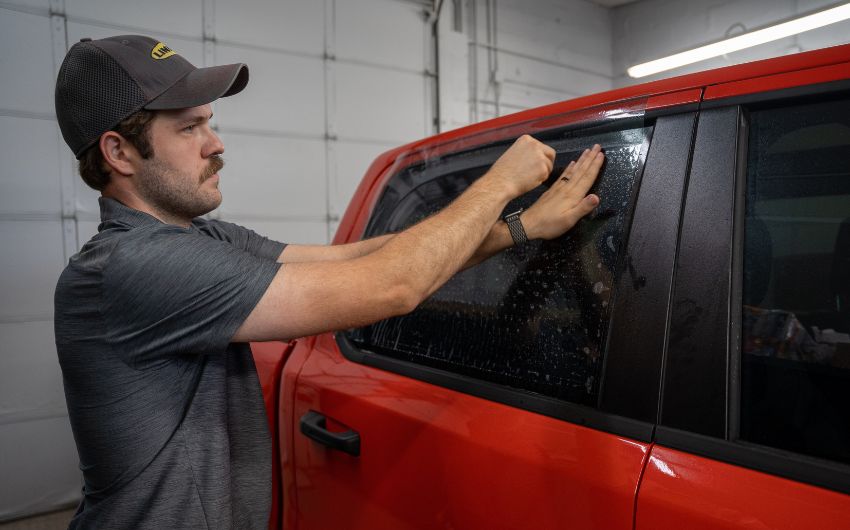Exactly How Car Window Tinting Keeps Your Vehicle Cool in Heat
Exactly How Car Window Tinting Keeps Your Vehicle Cool in Heat
Blog Article
Home Window Tinting Laws and Guidelines: What You Required to Know Before Tinting Your Auto
Prior to continuing with home window tinting for your car, it is crucial to acquaint yourself with the diverse regulations and guidelines that govern this technique throughout various states. These policies determine the acceptable levels of tint darkness, often measured by visible light transmission (VLT) portions, and consist of particular specifications for front windscreens aimed at ensuring road security.
Introduction of Home Window Tinting Laws
Window tinting laws are often based on variation across various territories, reflecting regional guidelines and safety factors to consider. These laws determine the permitted degrees of color darkness and reflectiveness on lorry home windows, ensuring that chauffeurs keep ample visibility while additionally securing versus unsafe UV rays and warm.
The majority of laws categorize window tinting based upon the Visible Light Transmission (VLT) portion, which shows the quantity of light that can pass via the window. Usually, reduced VLT portions indicate darker colors. Laws frequently distinguish in between the front, side, and rear windows, with stricter constraints put on the front windscreen to boost safety and security for both the motorist and various other road customers.
Conformity with home window tinting laws is crucial, as infractions can result in fines, obligatory elimination of the tint, and prospective rises in insurance policy costs. It is necessary for vehicle owners to familiarize themselves with local legislations before proceeding with home window tinting setups.
State-by-State Color Laws
Understanding the specific home window tinting policies in each state is important for lorry owners looking for to follow the regulation. Each state in the U.S. has developed its own set of guidelines regulating home window tinting, which can vary substantially. These regulations often dictate the allowed levels of color darkness, the kinds of home windows that can be tinted, and any clinical exceptions that may use.
For instance, states like The golden state have strict constraints on color darkness for front windows, while others, such as New Mexico, may enable darker tints. Furthermore, certain states mandate details visibility portions for different home windows, consisting of the windshield, front side windows, and rear windows. It is vital for car owners to acquaint themselves with their state's legislations to avoid potential penalties or charges.
Moreover, some states may call for a certification sticker label to be positioned on colored windows, indicating compliance with state laws. Failure to stick to these policies not only runs the risk of lawful consequences however can also influence security and exposure while driving. As a result, car proprietors ought to carry out detailed research or speak with local authorities to make sure complete understanding and compliance with state-by-state color guidelines.
Allowed Tint Degrees and Kinds
Numerous vehicle proprietors might be shocked to discover that enabled color levels and types vary commonly throughout different states. Each state has actually established its own guidelines pertaining to the permissible darkness and reflectivity of window color, frequently gauged by Visible Light Transmission (VLT) percents. VLT describes the amount of light that can pass via the colored home windows; thus, a reduced percentage indicates a darker tint.

In addition, the kinds of color products permitted can vary, with some states restricting mirror-like or metal finishes. It is vital for lorry owners to familiarize themselves with their state's specific regulations to make certain compliance. Non-compliance can result in important source penalties, necessary elimination of the color, or other legal consequences, making it important to comprehend these policies before continuing with installation.
Medical Exemptions for Tinting
While not all states offer allocations for medical exceptions concerning window tinting, those that do recognize the necessity for specific people to boost visibility and convenience as a result of clinical conditions. Different medical problems, such as lupus, skin cancer, and specific eye disorders, can provide people especially sensitive to sunlight. Consequently, these people might require darker tints to shield themselves from unsafe UV rays and glare.

It is vital to keep in mind that despite having a clinical exemption, there might still be restrictions on the degree of color enabled. Conformity with state legislations makes certain that people are both secured and within lawful limitations. Those thinking about medical exemptions should contact their neighborhood Department of Electric motor Automobiles or comparable authority to recognize the requirements and procedures needed to request an exception properly.
Penalties for Non-Compliance
Failing to comply with home window tinting regulations can cause significant charges, which differ by state. Law enforcement companies are equipped to release citations for lorries that do not stick to the defined tinting More Info policies. These fines normally include fines, which can vary from small amounts to numerous hundred bucks, depending on the intensity of the violation and the state in inquiry.
In some territories, repeated offenses may cause rising fines or additional penalties, such as mandatory court looks. Moreover, non-compliance may require the elimination of prohibited tinting, usually at the owner's expense. In severe instances, habitual transgressors may deal with suspension of their vehicle enrollment up until compliance is attained.
Furthermore, insurance policy ramifications might emerge from getting numerous citations for window color violations. Insurance providers might watch such offenses as an indicator of riskier behavior, potentially causing increased premiums or trouble in coverage.
To avoid these fines, it is essential for car proprietors to acquaint themselves with their local home window tinting legislations and make sure that their automobile complies (Window Tinting). This proactive approach not only avoids legal ramifications but additionally promotes roadway straight from the source safety
Final Thought

Many policies categorize window tinting based on the Visible Light Transmission (VLT) percentage, which indicates the quantity of light that can pass through the window. Conformity with window tinting policies is critical, as violations can result in penalties, obligatory elimination of the color, and possible boosts in insurance costs.Understanding the details window tinting laws in each state is essential for vehicle owners seeking to abide with the law. These regulations frequently dictate the allowed degrees of color darkness, the types of home windows that can be tinted, and any type of medical exceptions that might use.
For circumstances, states like California have rigid constraints on color darkness for front windows, while others, such as New Mexico, might allow darker tints.
Report this page